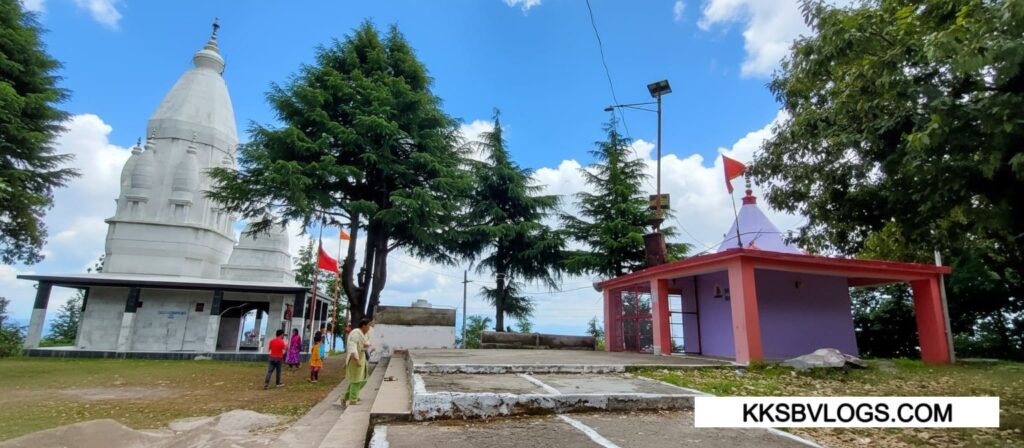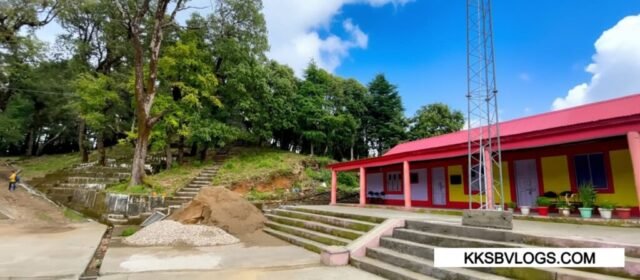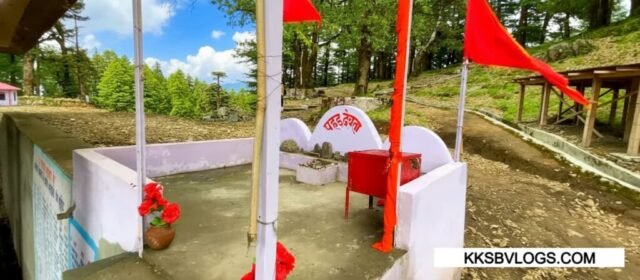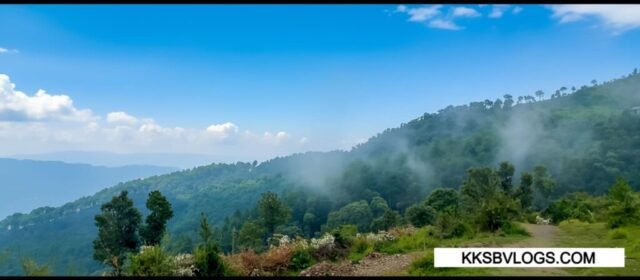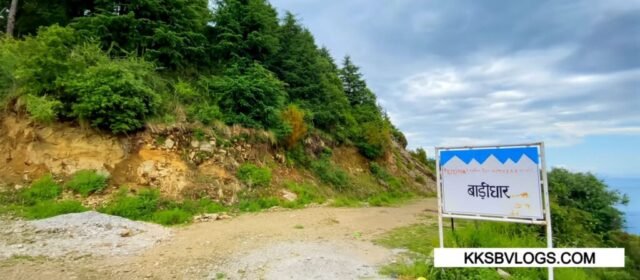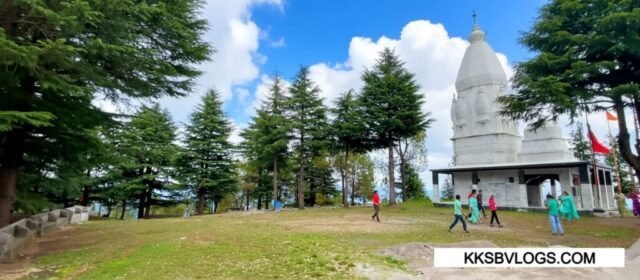1. Introduction
In the hills of Solan district, Himachal Pradesh, there lies a hill filled with the fragrance of devotion in the air — Badi Dhar (Badidhar) Valley and Shiv Temple.
This is a hidden destination where nature and tradition merge together to create spiritual harmony.
The temple is built on a high hill that offers 360° views of clouds, valleys, and mountain villages.
Locals call it “Badi ki Dhar” or “Badidhar Temple,” and every year a grand fair is held here in the month of June.
There is no crowd, no noise — just the echo of bells and the peace of wind.
We, the KKSB team, have visited this place many times, and every time it has given us a new experience.
Sunrise and sunset both bring a divine feeling here — as if Mahadev himself resides in both light and darkness.
2. Mythological & Historical Background – A Sacred Place Connected to the Pandavas
Badi Dhar Temple is one of those temples in Himachal Pradesh whose mention can be traced back to the Mahabharata era.
According to local legends, when the Pandavas were wandering through the mountains of Himachal during their exile, they performed tapasya (meditation) at several locations — and one of those was Badi Dhar Hill.
Here, Bhim and Arjun worshiped Lord Shiva, established a Shivling, and sought his blessings.
It is said that the Pandavas meditated here for eight days, and on the ninth day, Lord Shiva appeared before them.
At that moment, a divine light emanated from the hill, illuminating the entire valley — and hence the name “Badi Dhar,” meaning the ridge of great divine power.
Locals say that inside the temple there is an ancient stone with the imprint of Bhim’s mace (gada) on it.
They call it “Bhim ki Chhap” — considered the proof of the Pandavas’ meditation.
During the annual fair, the priest narrates an old legend —
“After the Pandavas’ meditation, Lord Shiva said:
‘Where you have established me, my energy shall forever remain manifest.
The flow of devotion on this hill shall never cease.’”
Thus, the Badidhar Temple is regarded as a holy site associated with both Lord Shiva and the Pandavas’ penance.
3. History & Heritage Significance
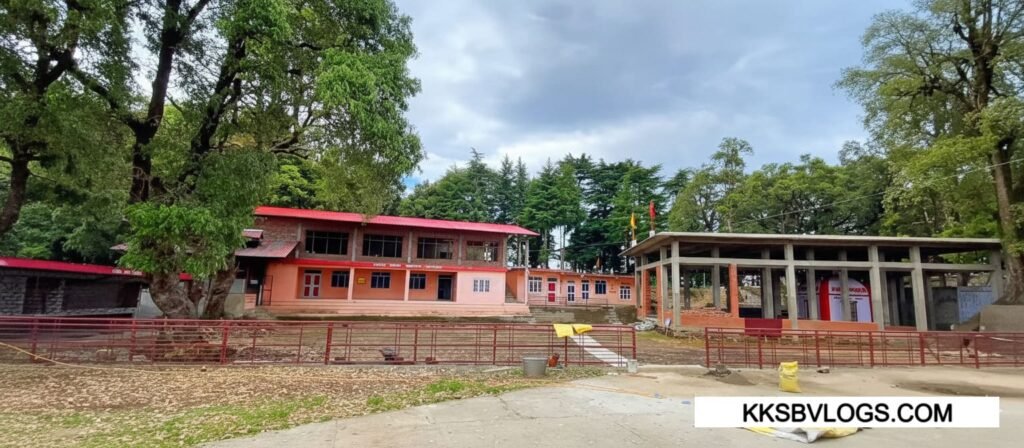
During the British period, when surveys of the hilly regions were conducted, “Badi ki Dhar” was mentioned as a holy hill.
In 1972, when Solan district was formed, this area was separated from Mahasu and included within Solan.
According to local historical sources and travel archives such as Wanderlog, the Badi Dhar Temple is estimated to be 350–400 years old, constructed during the 17th–18th century with stone and wood architecture.
The temple’s present form is an excellent example of traditional Himachali architecture —
a stone base, carved wooden frames, and a steep sloped roof designed for Himachal’s climate.
The Shivling inside is believed to be Swayambhu — that is, self-manifested.
Every year, on 14–15 June, the Badidhar Fair (Mela) is organized,
where people from 20–25 nearby villages gather for deepdaan (lamp offerings), bhajans, and community feasts.
Some locals offer a portion of their harvest to Lord Shiva, praying for prosperity and well-being in their homes.
4. Geography & Natural Beauty – A Hill Where the Air Itself Feels Divine
Badi Dhar Hill is located at an altitude of about 7000 ft (2100 m).
As you ascend the forest trail, the mix of pine trees, wild herbs, and bird songs creates a cinematic environment.
During monsoon, the mountains remain wrapped in mist, and in winter, snowfall turns the entire hill into a white carpet.
In summer, the air carries the fragrance of pine and the lush greenery refreshes the traveler’s soul.
There’s a unique peace in the air here — no vehicle noise, no crowd — only the melody of temple bells and the rhythm of the wind.
Badi Dhar is one of those rare places where nature and spirituality are felt together.

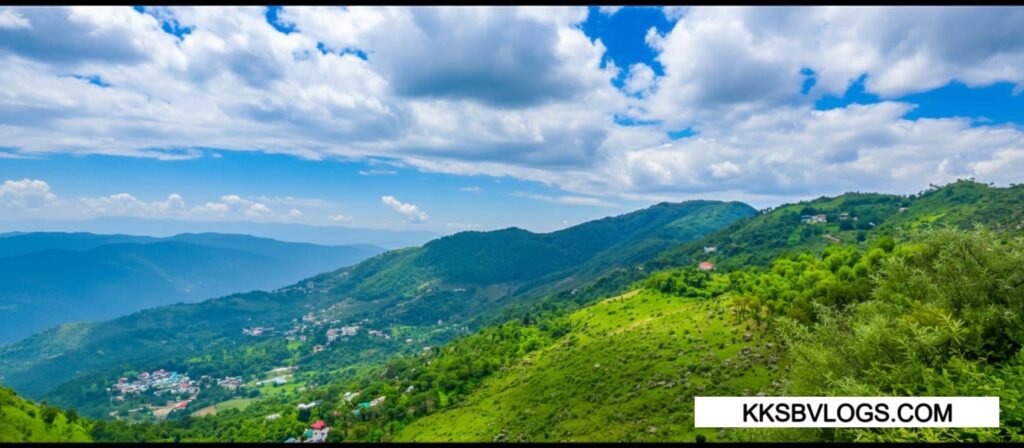
5. Things to Do at Badi Dhar Valley
1. Trek to the Top
A short and scenic trek (1–1.5 km) — perfect for beginners.
The trail passes through pine forest and small rocky sections — ideal for photography.
2. Sunrise & Sunset View
Badi Dhar’s sunrise and sunset are among the best hill views in Himachal.
In the morning, clouds float below, and in the evening, the sky glows pink-orange.
3. Meditation & Peace Time
Sitting in the temple courtyard, listening to the sound of bells and wind, feels like natural therapy.
4. Attend the Annual Fair
Held in June, the Badidhar Mela gives a glimpse of local culture and tradition — with bhajans, Himachali Nati dance, and bhandara feasts creating a festive vibe.
5. Camping Under the Stars
There’s a flat open area near the hill where you can pitch a tent.
At night, the sky is crystal clear, filled with stars and valley lights — a mesmerizing frame.
For safety, carry a guide and firelight, as foxes and porcupines are sometimes spotted in the forest area.
6. Best Time to Visit
| Season | Temperature | Highlights |
|---|---|---|
| March–June | 15–25°C | Pleasant weather, perfect for trekking |
| July–September | 18–22°C | Greenery and mist-covered hills |
| October–February | 5–15°C | Snowfall and crystal-clear sunsets |
Pro Tip:
Morning between 6–8 AM is best — soft light and clear valley views.
During monsoon, the trail gets slippery, so wear grip shoes.
7.How to Reach
- Nearest Town: Solan (≈ 22 km)
- Route: Solan → Arki → Badi Dhar Village → Short Trek
By Car/Bike: Narrow but scenic road. Limited yet safe parking.
By Bus: Take Solan–Arki/Darlaghat route bus, then a local cab.
By Train: Nearest station – Solan (Kalka–Shimla line)
By Air: Chandigarh Airport (≈ 65 km)
Network is weak in some parts, so use offline maps.
8. Our Experience At Badi Dhar,
We’ve visited Badi Dhar many times — and every time, this place gives us something new.
The first time, we left Solan at 5 AM and reached the temple hill by 6:30 AM.
Clouds were below us, and it felt like we were walking amidst them — as if Himachal had arranged divine darshan in silence.
The sunrise moment can never be forgotten.
When the first rays of the sun fall on the temple dome, the echo of bells mixes with the wind, creating a divine vibration.
In the evening, when the sun sets behind the mountains, the sky fills with pink and orange hues — a painting of peace.
Once, we tried camping near the hill.
We set up a tent on a flat patch, and though the wind was strong at night, the sky was filled with countless stars, as if the universe itself was speaking to us.
We sometimes heard the sounds of foxes or porcupines, but sitting around the campfire, listening to the bells and wind, was a memory for life.
In the morning, when we lit the diya near the temple, it felt as though the mountain itself was breathing.
Every trip brings the same realization — this place makes your soul lighter.
No crowd, no noise — only nature and devotion.
Badi Dhar is a place where not only wishes, but inner peace is fulfilled.
Whoever comes here once, always wishes to return — because there’s a magnetic pull in the air of this hill, calling you back again and again.
9. Nearby Attractions – Explore More Around Badi Dhar Hill
Around Badi Dhar Temple, there are several spots where mountain culture, history, and nature coexist beautifully.
If you’re visiting here, include these in your one-day plan 👇
1. Lutru Mahadev Temple (Approx. 27 km)
An ancient Shiva Temple located between Solan and Arki.
Built in traditional stone and wooden architecture, this temple offers mesmerizing sunrise views from nearby hills.
Local belief says that prayers to Lord Mahadev here are always fulfilled.
2. Arki Town (Approx. 25 km)
An old hill town where traditional Himachali architecture and royal heritage blend beautifully.
Narrow lanes, old havelis, and the charm of the local market make it a special hill destination.
3. Arki Fort (Approx. 24 km)
A symbol of Rajput and Gorkha rule, built in the 17th century.
Famous for its wall murals and Pahadi–Rajasthani fusion design.
At sunset, the entire Arki valley glows golden from here.
4. Batal Village (Approx. 22 km)
A quiet, green Himachali village where the simplicity of mountain life still thrives.
Locals are friendly, and the homemade pahadi food and natural lifestyle make it an authentic experience.
5. Kunihar Town (Approx. 35 km)
Known as the “Valley of Kings,” Kunihar is famous for its royal history and scenic beauty.
Ancient temples and lush green meadows make it a peaceful stopover.
Perfect Day Loop:
Morning – Badi Dhar Hill & Temple darshan
Noon – Arki Fort & Arki Town sightseeing
Evening – Lutru Temple & Kunihar sunset halt
📍Badi Dhar Location, Photos & Videos
Location: Badi Dhar (Badidhar) Temple & Valley – Near Arki Road, District Solan, Himachal Pradesh
Situated at around 7000 ft (2100 m) altitude, this divine hill lies between Solan and Arki, surrounded by dense pine forests and mist-covered ridges.
It’s easily accessible from NH-5 (Chandigarh–Shimla Highway) via Solan town.
Google Maps: Search “Badi Dhar Temple – KKSB Vlogs” on Google Maps for the exact pin & route direction.
(Offline map download recommended – ridge area me network kabhi-kabhi weak milta hai.)
Watch: Full travel reels, drone shots, and temple walk-through videos available on YouTube – KKSB Vlogs.
Check out sunrise clips, camping scenes, and the annual Badidhar Mela reels captured by the team.
Follow: For latest updates, behind-the-scenes content, and upcoming offbeat travel explorations, follow Instagram – @official_kksb
Badi Dhar Temple Location
Badi Dhar Temple Photos
❓ FAQs About Badi Dhar Temple, Solan
Where is Badi Dhar Temple located?
It is located in Solan district, Himachal Pradesh, near Arki road, on a high hill that offers 360° valley views.
Which deity is the temple dedicated to?
It is dedicated to Lord Shiva, where an ancient Swayambhu Shivling is established.
Is Badi Dhar connected with the Pandavas?
Yes, according to local belief, the Pandavas meditated here during their exile and established a Shivling to seek Lord Shiva’s blessings.
What is the best route to reach Badi Dhar Hill?
From Solan, take the Arki road to Badi Dhar village; from there, a 20–25-minute trek leads to the temple hill.
Is camping and sunrise viewing possible?
Yes, there’s open space near the hill for camping. Both sunrise and sunset are the best experiences here.
What is the best time to visit Badi Dhar?
From March to June and October to February, the weather stays pleasant. During monsoon, the greenery is at its peak.
What can be explored near Badi Dhar Temple?
Nearby attractions include Lutru Temple, Arki Fort, Arki Town, Batal Village, and Kunihar Town.
Is Badi Dhar Temple safe for families?
Absolutely — it’s a peaceful and family-friendly hill temple offering both nature and spiritual calm.

